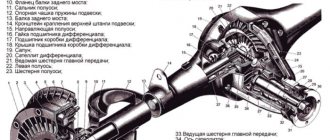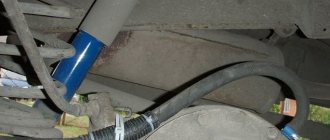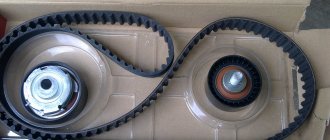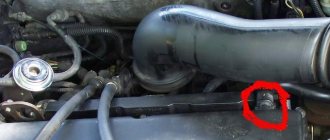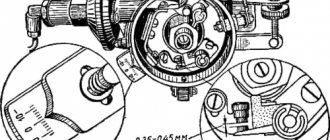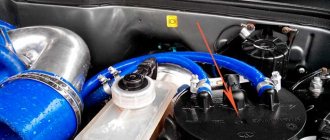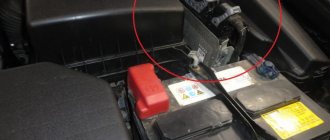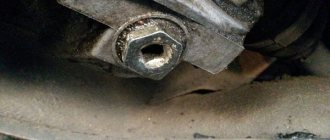A car uses a large number of components and assemblies, inside of which there are technical fluids and lubricants. During operation, such liquids heat up, that is, they increase in volume and the pressure inside increases.
Taking into account the fact that the systems and units themselves are sealed, closed (there is no direct communication with the atmosphere), pressure differences occur inside relative to atmospheric pressure. This difference must be equalized to prevent depressurization, leaks and damage.
For this reason, the engine cooling system has a special valve, which on modern cars is located in the cap of the expansion tank. As for the internal combustion engine or gearbox, a similar function is performed by the engine breather and the breather on the gearbox. Next, we will look in detail at what a gearbox breather is, why it is needed, and how this element is designed and works.
The principle of operation of the breather in the engine
Today, a breather valve to reduce pressure is very often installed on SUVs. This is because the device is suitable for off-road driving and prevents oil leakage. Heated engine oil expands, causing engine pressure to increase.
The pressure in engines or in other automotive devices must find a way out. This causes oil to leak out through various gaskets and gaps. To prevent oil leakage, breather valves are installed.
All breathers in the car should be checked periodically. Due to the constant movement of oil, debris and dirt remain in it. The valve must be properly removed and cleaned of contaminants. If it is too dirty, then it must be replaced with a new device. Before installing a new valve, be sure to thoroughly clean the installation area of dirt and debris. This is done to prevent debris from getting into the new device.
What is a breather in a car and how it works
Why does oil get into the air filter, the main reasons, what to do, how to avoid the problem Why does oil get into the air filter and what to do
What is a breather for?
The device reduces pressure when gaseous substances are released from the engine housing, and it helps to quickly reduce pressure. In the automotive world you can find different cars. In some models and brands, breathers are installed not only in the engine, but also in the gearbox, for transfer cases, gearboxes and the rear axle of the car.
The principle of operation of the breather in the engine
Today, a breather valve to reduce pressure is very often installed on SUVs. This is due to the fact that the device is suitable for off-road driving. Breathers prevent oil leakage. Heated engine oil expands, causing engine pressure to increase.
The pressure in engines or in other automotive devices must find a way out. This causes oil to leak out through various gaskets and gaps. To prevent oil leakage, breathers are installed.
All breathers in the car should be checked periodically. Due to the constant movement of oil, debris and dirt remain in it. Breathers must be properly removed and cleaned of contaminants. If it is too dirty, then it must be replaced with a new device. Before installing a new valve, be sure to thoroughly clean the installation area of dirt and debris. This is done to prevent debris from getting into the new device.
Breather in gearbox
The gearbox must convert the torque in the engine and also change the traction force. It often happens that the gearbox starts to work poorly due to the fact that the gearbox breather is clogged. To avoid any damage, you should clean not only the breather in the engine, but also all the others that are installed in different parts of the machine.
In the gearbox, the breather is located on the gearbox housing cover. Sand or dirt getting into the breather will cause the wheel mounted on the secondary shaft to jam. As a result, wear of bearings and synchronizers increases. It is necessary to wash the breather during each technical inspection, or even more often. If the valve is clogged, the pressure in the gearbox will increase, which will lead to oil leakage through the seals.
Bridge breathers
There is oil inside each axle that connects the wheels. The internal cavity must contact the external environment, and it does this through the breather. With the help of this valve, an increase in pressure inside the bridge itself is eliminated.
Oil pressure rises when it heats up during forward gear operation. The breather also performs a protective function. It protects the bridge from water entering it when the car overcomes a water barrier. There is also a special hole in the middle of the bridge through which oil drains.
Particular attention should be paid to the rear axle crankcase breather. It is located on the rear axle boat, on the right side, at the top
As a result of this valve being clogged, oil may leak. To get rid of this problem, you need to clean the breathers from dirt. You also need to check the free movement of the breather cap. It should move in all directions.
After cleaning the breather, you should check it again after a short run of 20 km. If traces of oil are detected again, this will indicate a malfunction of the device that needs to be replaced. The rear axle breather must always be in good condition, because it plays an important role in the operation of the entire vehicle.
Share information with friends:
Breather in gearbox
The gearbox must convert the torque in the engine and also change the traction force. It often happens that the gearbox starts to work poorly due to the fact that the gearbox breather is clogged. To avoid any damage, you should clean not only the breather in the engine, but also all the others that are installed in different parts of the machine.
In a gearbox, the bypass valve is located on the gearbox housing cover. The ingress of sand or dirt will cause the wheel mounted on the secondary shaft to jam. As a result, wear of bearings and synchronizers increases. It is necessary to wash the breather during each technical inspection, or even more often. If the valve is clogged, the pressure in the gearbox will increase, which will lead to oil leakage through the seals.
Bridge breathers
There is oil inside each axle that connects the wheels. The internal cavity must be in contact with the external environment, and it does this through the valve. With the help of this valve, an increase in pressure inside the bridge itself is eliminated.
Oil pressure rises when it heats up during forward gear operation. The breather also performs a protective function. It protects the bridge from water entering it when the car overcomes a water barrier. There is also a special hole in the middle of the bridge through which oil drains.
Particular attention should be paid to the rear axle crankcase breather. It is located on the rear axle boat, on the right side, in the upper part. As a result of this valve being clogged, oil may leak. To get rid of this problem, you need to clean it of dirt. You also need to check the free movement of the breather cap. It should move in all directions.
After cleaning, you should check it again after a short run of 20 km. If traces of oil are detected again, this will indicate a malfunction of the device that needs to be replaced. The rear axle breather must always be in good condition, because it plays an important role in the operation of the entire vehicle.
Source
Transmission breather: what is it for and how it works
A car uses a large number of components and assemblies, inside of which there are technical fluids and lubricants. During operation, such liquids heat up, that is, they increase in volume and the pressure inside increases.
Taking into account the fact that the systems and units themselves are sealed, closed (there is no direct communication with the atmosphere), pressure differences occur inside relative to atmospheric pressure. This difference must be equalized to prevent depressurization, leaks and damage.
For this reason, the engine cooling system has a special valve, which on modern cars is located in the cap of the expansion tank. As for the internal combustion engine or gearbox, a similar function is performed by the engine breather and the breather on the gearbox. Next, we will look in detail at what a gearbox breather is, why it is needed, and how this element is designed and works.
Breather in the gearbox: operating principle and features
So, in order to understand what a breather is in a car, it should be noted that in fact it is a valve that allows you to reduce the pressure in the crankcase of a sealed unit (engine, gearbox, etc.) A breather, breather or breathing valve is a device through which the container communicates with the atmosphere, and even taking into account the temperature difference in the container, it is possible to maintain atmospheric pressure.
As you know, the gearbox performs the task of converting torque from the engine, after which torque is transmitted to the drive wheels. The box itself is filled with transmission oil, which tends to heat up during operation of the gearbox, expanding in volume. The result is an increase in pressure that needs to be relieved. If this is not done, the pressure in the gearbox will be increased, which will cause oil to leak from the gearbox through the seals, seals and gaskets.
It is not difficult to guess that oil leaks from the gearbox will lead to the lubrication level dropping, the box will begin to work poorly, and will also wear out quickly and actively. First, the driver experiences difficulties and discomfort (gears engage worse), then extraneous noise appears (hum, vibration of the box), then synchronizers, bearings, gears and other gearbox elements fail. In the gearbox, the breather is installed on the gearbox housing cover.
Another important function of the box or axle breather, as well as the engine, is protection from dust, dirt, water, etc. This is especially true for car axles, since the bridge is an open element (for example, on an SUV) and can be submerged in water or mud when driving through difficult areas.
Useful tips
As a general rule, you should check all existing breathers on a particular vehicle (engine breather, transmission breather, axle breather, etc.). The fact is that oil particles can be squeezed out through the breather during its operation, which leads to active contamination.
In practice, breathers need to be dismantled and cleaned of dirt and oil residues. If cleaning does not produce results (in the case when oil “presses” out of the gearbox, motor or axle precisely because of a faulty breather), the device must be completely changed.
Also, before cleaning, you need to know how to remove the breather. On many cars, it is enough to remove the rubber cap on top and then clean the valve. Some other models may not have a rubber breather cap, and the breather is located in the 5th gear cover. In this case, cleaning is also carried out using improvised means.
What determines the performance of the breather?
Manufacturing defects and neglect of maintenance. Despite the fairly simple design, for normal operation the part requires special precision in manufacturing.
- In this way, the forces to compress the spring must be accurately calculated;
- To make a rubber mug, you need very high-quality raw materials, otherwise it can melt, deform and even stick to the fitting, which is unacceptable and leads to malfunctions;
- any distortions or jamming of the cap are unacceptable. If the breather is made with a defect, it becomes dirty faster, sticks and when heated, it squeezes out not air, but oil; when oil is mixed with water, an emulsion is formed.
It's like with car optics. You can buy a home-made product, it will look the same, illuminate the road almost the same, but instead of 40,000 hours of service, the factory product will last 5,000, the body will not be shock-resistant, the headlight will begin to fail almost immediately after purchase, while it should be used for at least 4 years . If you want good LED headlights, buy factory ones from a trusted store; our favorite is Wesem-Light. Any part, including the breather, must be of high quality and original, since its failure can lead to expensive repairs.
Even if your car is equipped with factory-made breather Turn the cap from time to time, making a characteristic hissing sound, which is considered normal. Then the part will not become overgrown with dirt inside, and the rubber part will not sour.
Let's sum it up
Taking into account the above information, it becomes clear that even with its apparent simplicity, the breather of a gearbox, engine or axle performs a rather important function. This means that the condition and proper operation of this element must be monitored.
This is especially true for SUVs, trucks and special equipment, where in addition to gearboxes and internal combustion engines, breathers are installed on bridges. Such machines are often operated in harsh conditions, as a result of which the gearbox or axle pressure reduction valve may become dirty or fail more often (especially the rear axle breather).
Also, the unit or assembly itself may stop working normally, which subsequently leads to serious damage. For this reason, it is necessary to clean the breathers installed on different units and elements of the car at every service. If the car was driven off-road, it is recommended that after such trips you immediately wash the breathers to remove dirt and sand.
Transmission oil leakage from the gearbox: manual transmission and automatic transmission. The main reasons why a leak occurs are box repairs.
Why oil leaks from the engine breather: signs and main causes of such a malfunction. How to understand why oil is flowing through the breather, troubleshooting.
Why does engine oil start to drip or leak at the junction of the engine and gearbox. How to accurately determine the cause of a lubricant leak, methods of diagnosis and repair.
Purpose and principle of operation of the breather. Why are breathers installed on internal combustion engines, gearboxes and axles? When it is necessary to clean the breather, useful tips and recommendations.
Causes of oil leaks in the oil filter area: oil flows from under the filter, through the housing, in the area of the fitting, etc. Available diagnostic and repair methods.
How to change the oil in a DSG gearbox: changing the oil in a DSG gearbox. What to consider when replacing, selecting oil for DSG, tips and tricks.
Source
Troubleshooting
The first thing you need to pay attention to is the color of the exhaust, blue or black smoke, a sign of burnt valves or problems with rings. Next, you should check the compression in all cylinders. The value on gasoline internal combustion engines should be within 11-13 MPa. Disconnect the pipes from the valve covers, air intake and breather
Assess the degree of contamination. If the pipes are very dirty or clogged with oil deposits, use gasoline to clean them or a special carburetor cleaner. Check the condition of the oil separator. Unscrew the required bolts to get to this unit. Remove the oil separator and assess its condition. If necessary, clean or rinse followed by drying. Inspect and, if necessary, flush the breather valve. There are situations when the valve gets stuck, resulting in exhaust gases entering the crankcase and creating excess pressure. Remove the part and wash it; in most cases, this will resolve the issue of squeezing oil out of the breather.
Helpful advice! To distinguish stuck rings from a burnt-out valve, it is enough to perform several manipulations. After checking the compression in the cylinders, determine the cylinder with the lowest value. Then inspect the spark plug of this cylinder; if the rings are lodged in this cylinder, the spark plug will be covered with a thick oil layer. If the valve is burnt out, the spark plug will appear normal without any major abnormalities.
Finally…
The problem of oil escaping through the breather worries many motorists and causes a lot of trouble, but with timely detection of the problem and the right approach, serious consequences can be avoided
It is important to ensure that the oil level is normal, as soon as you find that the engine is taking oil, monitor its level and constantly monitor that it does not fall below the permissible level
Also pay attention to the breather and filter; oil on the air filter in large quantities also does not bode well. Regularly monitor the condition of the engine and all systems, and also promptly correct any malfunction
This will save you from engine overhauls and unnecessary waste.
PURPOSE
The task of the breather in a car design is to connect the engine sub-piston space with the atmosphere. Additionally, the breather is installed in the valve cover of the block head.
During operation of the power plant, the movement of components, mechanisms, and lubricant leads to an increase in pressure inside the crankcase and under the cover. In addition, crankcase gases accumulate in the sub-piston space, which also increases the pressure.
Piston rings are not able to ensure complete tightness of the combustion chamber, so some of the working gases break through and enter the sub-piston space.
The operation of the motor is accompanied by temperature changes, which causes condensation to form inside. The accumulation of moisture inside the motor is unacceptable, since it is the main cause of corrosion.
A mixture of working gases that have broken into the crankcase, moisture, and oil particles that are mixed in contact with the lubricant are called crankcase gases. An increase in pressure inside the crankcase is usually accompanied by a deterioration in engine performance, since gases create additional resistance to components and mechanisms.
If gases accumulate in large quantities in the sub-piston space, then they break through leaks and “weak” components - oil seals, dipstick, seals, etc.
Therefore, it is important to equalize pressure and gas removal. And this is done by the breather, which is essentially an air valve. Note that this element is used not only on the engine, it is also used in gearboxes and rear axles.
In addition to maintaining pressure in the cylinder block, many car enthusiasts use the breather to diagnose the engine. It helps determine the degree of wear of the cylinder-piston group and the position of the rings.
When engine components wear out or piston rings become coked, a large amount of gases enters the sub-piston space. And thanks to the breather, this is clearly noticeable by the smokiness of the crankcase gases escaping. If the CPG is in good condition, there is practically no smoke in the crankcase gases.
Operating principle of the crankcase ventilation system
Oil smells like gasoline reasons
In order to understand why oil is squeezed out of the breather, I propose to briefly consider the principle of operation of the oil system. Not many people know, but for proper operation of the engine, ventilation is necessary, since during its operation gases collect in the crankcase, and now we are not talking about exhaust gases. To ensure the removal of these gases, old cars used a so-called crankcase ventilation system, which after some time became known as a “breather.” With the help of a breather, engineers were able to ventilate the crankcase and thereby relieve the pressure that forms during engine operation. However, the system turned out to be ineffective, since tiny oil particles penetrated the breather along with excess pressure and gases.
The issue of penetration of “oil dust” into the breather was partially resolved by means of a special mesh that traps oil particles and does not let them into the breather. However, despite this, some of the oil vapors still penetrate into the breather, creating certain difficulties for owners. A small amount of oil that has penetrated into the breather is not considered anything terrible, however, if oil flows out of the breather in large quantities, this is a reason to seriously think about the technical condition of the engine.
Bridge breathers
There is oil inside each axle that connects the wheels. The internal cavity must contact the external environment, and it does this through the breather. With the help of this valve, an increase in pressure inside the bridge itself is eliminated.
Oil pressure rises when it heats up during forward gear operation. The breather also performs a protective function. It protects the bridge from water entering it when the car overcomes a water barrier. There is also a special hole in the middle of the bridge through which oil drains.
Particular attention should be paid to the rear axle crankcase breather. It is located on the rear axle boat, on the right side, in the upper part. As a result of this valve being clogged, oil may leak. To get rid of this problem, you need to clean the breathers from dirt. You also need to check the free movement of the breather cap. It should move in all directions.
After cleaning the breather, you should check it again after a short run of 20 km. If traces of oil are detected again, this will indicate a malfunction of the device that needs to be replaced. The rear axle breather must always be in good condition, because it plays an important role in the operation of the entire vehicle.
An engine breather (breathing valve) is a device for equalizing the pressure in a closed container relative to atmospheric pressure. In other words, the breather valve allows the closed container to communicate with the atmosphere. In internal combustion engines, the breather equalizes the pressure inside the engine crankcase.
During the operation of the vehicle and the operation of the power unit, the pressure in the crankcase may increase, as a result of which crankcase gases escape through the breather, excess engine oil is squeezed out, etc. If the pressure in the engine crankcase is below atmospheric pressure, then outside air enters the crankcase through the breather, thereby eliminating the difference between external atmospheric and internal pressure in the crankcase cavity.
Where is the breather installed?
Breathers on a car are installed:
In the engine itself; V…
What kind of detail is a “breather”?
Most cars run on internal combustion engines. Petrol, gas or diesel fuel is “burned” in special compartments, but this process is impossible without mixing with air.
In combustion, it is important both the timely supply of air and the release of gas that creates excess pressure. The breather is responsible for the release of gas and the supply of air. If it fails, insufficient combustion air enters the system or excess gas accumulates.
In general, it is installed on all relatively large hollow components of equipment where there are lubricants and air. When heated, the oil expands and it is necessary to remove excess air; when it cools, on the contrary, the oil level drops and air fills the entire space.
DESIGN FEATURES
Previously, the breather was a regular fitting with a hose attached to it and directed downwards. This design ensured the removal of crankcase gases to the atmosphere. To prevent oil from escaping, an oil separator was installed in front of the breather. This element changed the trajectories of gas movement, while the oil, due to inertia, settled on the walls of the oil separator and flowed into the pan.
Crankcase ventilation system of VAZ 2111: 1. Engine crankcase. 2. Breather. 3. Hose from the breather to the valve cover pipe. 4. Oil separator under the valve cover. 5. A thin hose from the valve cover to the fitting with the throttle body nozzle. 6. Fitting with a jet on the throttle valve block. 7. Thick hose from the valve cover to the inlet pipe.
In modern cars, to improve environmental friendliness, a whole system for removing these gases is used. Thanks to it, they are not released into the atmosphere, but are fed into the cylinders, where they burn.
This system includes:
It is noteworthy that the crankcase gas exhaust system uses several oil separators - labyrinth, centrifugal, and mesh.
The breather is located in various places in the lower part of the engine block. It can be either a separate element or act as a housing for the probe.
The breather is a very simple element in design, but the performance of the engine depends on it. If you turn it off, then within a few minutes the increased pressure will squeeze out the oil. If the oil comes out through the dipstick, then you just need to restore the lubricant level and wipe the engine compartment. But if the oil presses through the crankshaft oil seals, then replacing them is impossible.
There are no moving parts in the breather, so there is nothing to break in it. But it still requires maintenance. The oil separator is not able to catch all the oil and oil particles remain in the gases. Some of them settle on the inner walls of the breather along with soot and pollutants. Gradually, the diameter of the tubes decreases, which impairs crankcase ventilation. In winter, frozen water is added to the dirt on the walls.
On some cars, the crankcase ventilation system provides for the supply of gas to the valve covers, where they additionally pass through an oil trap mesh before entering the cylinders. The honeycombs of this mesh are also clogged with dirt, so the throughput is reduced. This “results” in pushing through the camshaft seals.
Possible causes of smoke from the breather
- The part itself is dirty and worn out. If you periodically clean it and replace it in a timely manner, there will be no such problems.
- High wear of automobile oil or low quality of fuels and lubricants. Do not neglect the frequency of engine oil changes and do not buy counterfeit fluids, it is cheaper than a major engine overhaul.
- Exceeding the required oil level. Warm up the car and check the oil level with a special dipstick. Do not allow oil to escape through the breather.
- If you find white smoke on a hot engine, most likely there is a leak in the system and coolant is entering the lubrication system.
- There is a problem with the cylinder oil scraper rings (they could be worn out or stuck) here it is unlikely that it will be possible to decarbonize them with special chemicals, most likely you will have to disassemble the engine.
- The exhaust valves could burn out. Measure the compression and it will become clear whether this is true. If the assumption is confirmed, it will also be impossible to do without disassembling the engine.
- Critical wear of shaft seals or oil seals. We recommend immediately replacing them with new ones if wear is obvious and this is the cause of the smoke.
There are no small details in a modern car, and attention to the condition of parts and the performance characteristics of the car is the key to a long and reliable car service. Timely maintenance and replacement of failed (even such small and simple) parts can protect you from serious breakdowns and expensive repairs. Pay attention to your car, move the breather cap, do not forget to unscrew the breather and check for dirt, clean the part from it, and prevent smoke from appearing, then everything will be fine.
SERVICE
To eliminate the possibility of the seals being pressed through, you need to periodically clean the engine ventilation system. If you remove dirt twice a year, there will be no problems with the work, since the dirt is removed with a rag.
Dirty breather of Skoda Octavia
You should start with the breather itself. In some engines it is secured with bolts, while in others the breather is tightly seated in the seat.
After removing the breather wall, carefully wipe it with a rag. If the contamination is strong, then they are removed with wire or a screwdriver. Before installing the breather, wipe the seat.
We wash and clean the ventilation system pipes with a cleaning rod made of rags and wire.
The oil trap screen installed in the valve cover also needs to be cleaned. If it is slightly dirty, just wiping is enough.
If the mesh is heavily contaminated with deposits, then everything will have to be removed using a knife, screwdriver, or wire. You can also simply burn out the deposits. To do this, pour a little gasoline onto the grid and set it on fire.
Such simple actions allow you to keep the crankcase ventilation system, which includes the breather, in working order and prevent the seals from being pressed or oil being squeezed out through the dipstick.
VIDEO: BREATHER, WHAT IS IT AND WHY?
Some novice drivers are stumped by the question “engine breather and what is it,” because recommendations for the operation and care of a vehicle often mention this important element of the engine.
In addition, the breather often helps diagnose important problems associated with the power unit: the fact is that problems with this element can subsequently cause engine problems, which can then lead to expensive repairs.
That is why the car owner simply needs to know all the aspects and characteristics of the device, as well as have an idea of how to properly prevent disruptions in its operation, because the breather valve, which does not seem like a significant detail at first glance, is of great importance for the proper operation of the power unit.
Engine breather
Some novice drivers are stumped by the question “engine breather and what is it,” because recommendations for the operation and care of a vehicle often mention this important element of the engine.
In addition, the breather often helps diagnose important problems associated with the power unit: the fact is that problems with this element can subsequently cause engine problems, which can then lead to expensive repairs.
That is why the car owner simply needs to know all the aspects and characteristics of the device, as well as have an idea of how to properly prevent disruptions in its operation, because the breather valve, which does not seem like a significant detail at first glance, is of great importance for the proper operation of the power unit.
What is its purpose?
To understand what a breather is, it is recommended to find out what it is for, since this is directly related to its operating principle.
The main task of this device is to reduce pressure in the engine crankcase.
While the car is running, a lot of gases accumulate in the crankcase, which over time create high pressure. If they are not released in time, the engine may stop working, since high pressure will support the pistons, and gas will begin to escape through any other hole. To prevent this from happening, this valve is installed.
Another significant function of the device is to reduce the temperature inside the engine and ventilate it.
Based on the operation of this unit, one can draw conclusions about problems in the operation of the motor.
In normal operating condition, a slightly transparent, barely noticeable smoke can be seen from the unit. There are situations where the engine constantly throws out oil through the breather. This is a common cause of not only valve clogging, but also other technical problems.
The breather valve is an important element that allows communication with the external environment of a closed container. It allows you to equalize the pressure inside the internal combustion engine: if it drops sharply, fresh air will enter through the valve, which will eliminate the difference between the external, atmospheric, and internal pressure created in the crankcase cavity.
Installation location
The breather valve in a car is usually located:
- directly in the engine;
- inside the rear and front axle structures;
- at the checkpoint.
Principle of operation
Regardless of the installation location, the functions of the breather remain the same.
In other words, the valve allows the structural components of the car to “breathe”, from which working fluids are not allowed to leak and into which small particles from the outside should not enter.
While the engine is running, the oil inside the crankcase tends to heat up, which leads to an increase in engine temperature.
During this, the air in the crankcase begins to expand and creates pressure that must be relieved.
When cooling, on the contrary, the pressure in the crankcase quickly drops, which is why air from outside tries to break through any available holes. In order to counteract such phenomena and completely safely equalize the pressure on the engine, this device is installed.
Why do you need to clean the valve?
The external conditions created during the operation of the breather valve often lead to the accumulation of dust and dirt in it, which interfere with its normal functioning. Because of this, excess or, conversely, insufficient pressure occurs, leading to oil leakage.
The breather should be replaced with a new one in cases where it is too contaminated, and before installing a new unit, it is recommended to thoroughly clean the place where it is installed, which will avoid rapid contamination again. Breathers of other important components of the car also need to be cleaned in a timely manner to prevent car malfunctions.
Important
The breather is an important element that helps the car operate properly, but to prevent breakdowns it is recommended to clean or change it in a timely manner.
A faulty valve can lead to various problems:
- risk of gearbox leakage;
- rapid wear of synchronizers and much more.
Regular cleaning of the valve will help protect the oil from deterioration in its lubricating and protective properties, and therefore will extend the life of the iron horse for a long time.
What is it and what is its role
The main task of this breather is to maintain the required pressure in a closed container. While the engine is running, various gases accumulate inside, and if they are not released, the engine will not be able to operate normally. In very simple terms, this is a valve that releases excess air when pressure increases.
Another useful function of this device: lowering the temperature and ventilating the engine.
Important point. In addition to its main functions, the breather is a kind of filter and prevents dust and dirt from entering the engine.
Why do you need to clean the valve?
The external conditions created during the operation of the breather valve often lead to the accumulation of dust and dirt in it, which interfere with its normal functioning. Because of this, excess or, conversely, insufficient pressure occurs, leading to oil leakage.
If situations arise when oil is thrown through the unit, first of all you should check whether it is clogged. To prevent oil from being thrown out, you need to remove the valve for cleaning or replacement.
The breather should be replaced with a new one in cases where it is too contaminated, and before installing a new unit, it is recommended to thoroughly clean the place where it is installed, which will avoid rapid contamination again. Breathers of other important components of the car also need to be cleaned in a timely manner to prevent car malfunctions.
Features of breather maintenance
Due to the simple design and low cost of the part, when it fails it is usually replaced; the breather is not intended for long-term maintenance-free operation. It is worth checking the condition of the breather at least twice a year and cleaning it inside and out with ordinary rags. The process is simple and quite fast.
By and large, the only malfunction that you may encounter is a decrease in throughput, and if the breather does not release gas, it is still better to replace it, but if during inspection you notice that smoke is coming from the breather, this may be an indicator of a serious problem.
Where is
In most cases, the breather is located near the oil filler neck , with a hose coming from it connected to the air filter housing. In addition to installation directly into the motor, the device can also be found in such places as:
Reference. It is necessary to periodically clean the device (every 10-15 thousand kilometers). And if you often have to drive off-road and cross water obstacles, then cleaning after 2-3 trips would be ideal.
